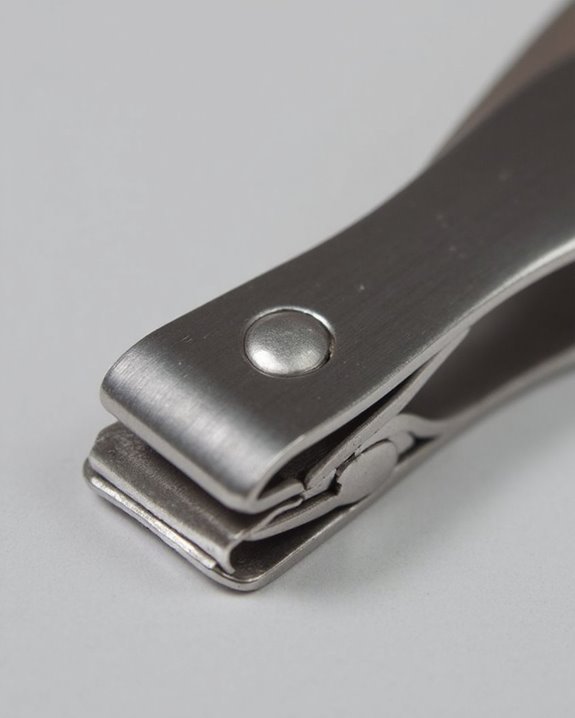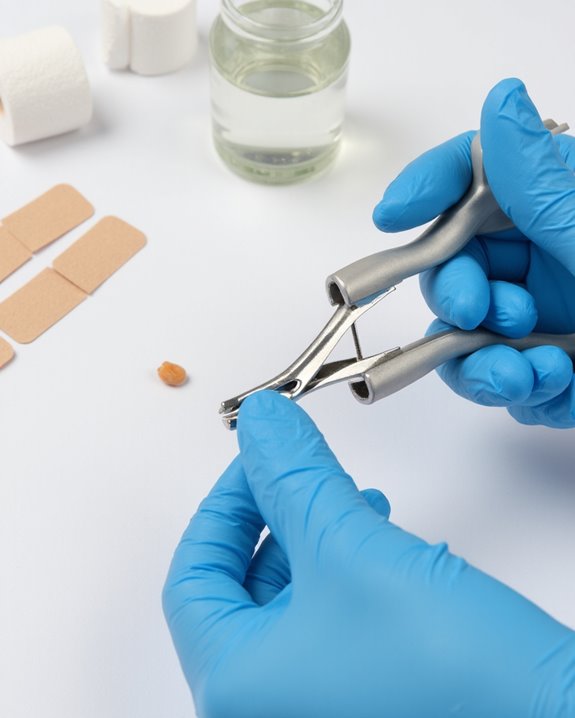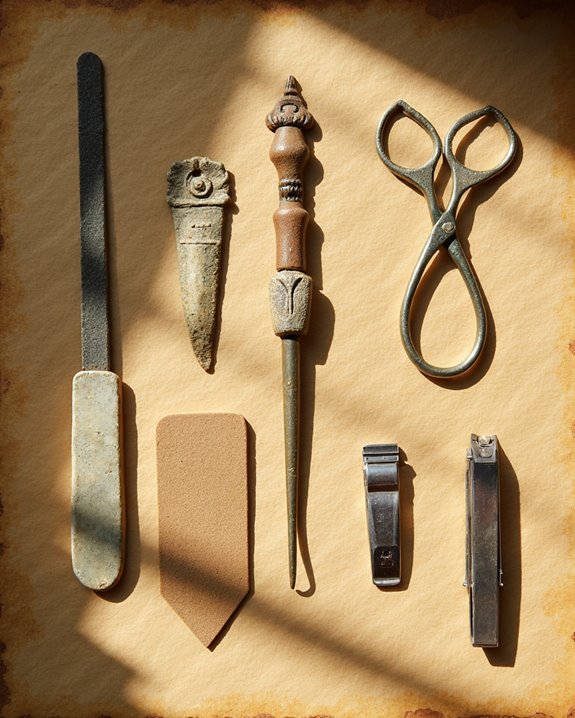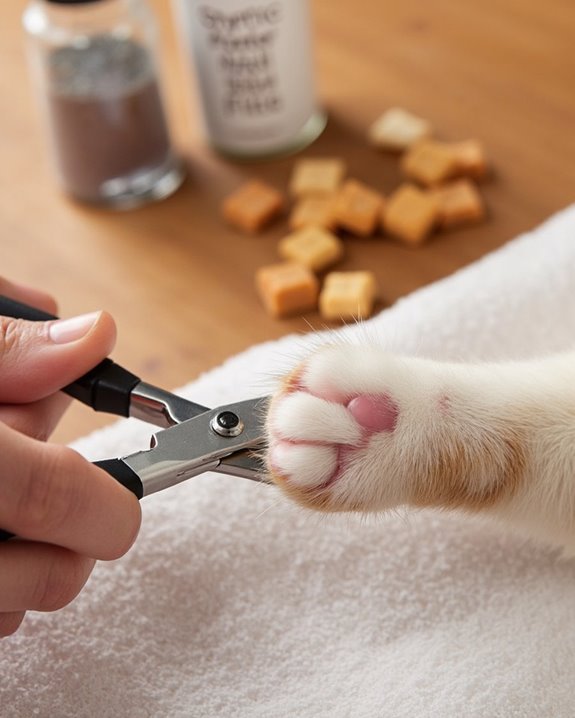To trim your dog’s nails without clippers, I recommend preparing alternative tools like a Dremel grinder or glass nail file first. Begin by acclimating your pet to paw handling through gentle touches with treats and praise. Introduce the tool gradually, keeping sessions short to avoid stress. When filing, work at low speeds for 5-10 seconds per nail, taking breaks to prevent overheating. Always file gradually to avoid the quick, rewarding your dog after each nail. These techniques offer safer alternatives that many dogs find less stressful than traditional clipping.
Key Takeaways
- Motorized nail grinders provide a gentler approach by gradually filing nails instead of making abrupt cuts.
- Manual glass or metal nail files offer excellent control and are ideal for dogs anxious about motorized tools.
- Acclimate your dog to paw handling through short sessions with treats before attempting any nail maintenance.
- File each nail for 5-10 seconds at a time, taking breaks to prevent overheating and discomfort.
- Always file in one direction with consistent pressure, watching for the quick to avoid causing pain or bleeding.
Understanding Why Nail Maintenance Matters
Why does regular nail care matter so much for our canine companions? When I examine a dog’s overall health, I always check their nails because properly maintained nails directly impact their mobility and comfort. Dogs that grow long nails face several serious risks, including painful dew claws that curve back into leg skin, causing infections that require veterinary intervention. I’ve seen many cases where untrimmed nails split or snag on carpeting, creating painful tears that could have been prevented. Proper nail maintenance also reduces risk of injury, especially during active play or sudden movements. To keep their nails short, owners must understand that overgrown nails reduce traction on slippery surfaces, increasing fall risks and potentially altering a dog’s gait over time. Even naturally active dogs who wear down nails on pavement need regular checks. Maintaining a Dog’s Nails Safely prevents long-term joint strain and mobility issues that diminish quality of life.
Gathering Alternative Tools for Nail Care

Selecting the right tools transforms the nail trimming experience from stressful to manageable for both you and your dog. I recommend investing in a motorized nail grinder, such as a Dremel, which offers gentle filing without the abrupt cut of traditional nail clippers. When I cut your dog’s nails without clippers, I prefer using a high-quality glass nail file, which provides excellent control and doesn’t generate excessive heat during use. Glass nail files are durable, easy to clean, and gentle on nails, making them an ideal choice for precise grooming. For best results, gather nail files with varying grits—coarse for initial shaping, finer for finishing touches. Many new products from reputable pet care brands offer specialized features like variable speeds on grinders and ergonomic handles on manual files. I suggest having multiple options available, as some dogs may prefer the quiet approach of a manual file while others tolerate the quicker work of a motorized tool.
Acclimating Your Dog to Paw Handling

Before diving into any nail maintenance, how comfortable your dog feels with having their paws touched will determine your success. Getting your dog used to paw handling requires patience and consistency, ideally beginning weeks before attempting nail care.
I recommend starting with brief, gentle touches to your dog’s paws for just seconds at a time, immediately following with praise and treats to build positive association. Keep sessions short (5-10 minutes) and schedule them on different days to prevent overwhelming your pet. As your dog comfortable with basic touches, gradually progress to holding the paw, then to light squeezing and spreading the toes. Always watch your dog’s body language during these sessions, pausing immediately if you notice signs of stress like pulling away or whining. This methodical approach builds trust that makes future nail maintenance greatly easier.
Using a Dremel Tool Effectively
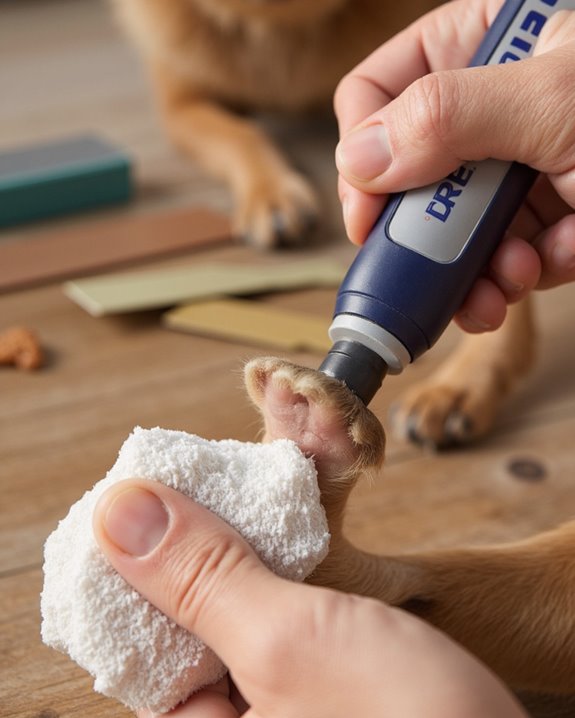
A motorized Dremel tool offers a gentler alternative to traditional nail clippers, gradually filing down your dog’s nails rather than cutting them in one motion. I recommend purchasing a pet-specific nail grinder with a sanding band attachment from your local pet supply store for best results. To make the process less stressful, I always start by introducing the tool at low speed while offering treats, helping my dog get used to the process. Before grinding, I trim excess toe hair and gently separate each toe. When filing, I operate the Dremel at low speed for just 5-10 seconds on one nail at a time, taking breaks to prevent overheating. I’m careful to avoid the quick, filing gradually and checking my progress frequently. Using a high-quality motor ensures consistent performance and reduces the risk of the tool stalling or overheating during use. After each successful nail, I reward my dog with praise and treats to reinforce positive associations.
Manual Filing Techniques for Anxious Dogs
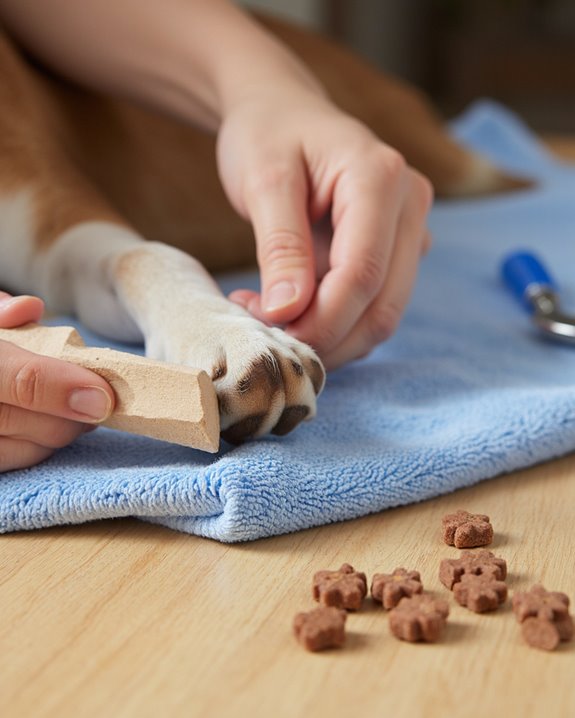
When your dog exhibits signs of anxiety during nail trimming, manual filing offers a gentler, less intimidating alternative to clippers or power tools. I’ve found that using specialized dog nail files made of hard metal, ceramic, or glass provides better control to make the process less stressful.
Start by trimming the hair between your dog’s toes to guarantee clear visibility of each nail. You’ll need to make sure you gently spread each toe to access individual nails, filing with light, consistent strokes for 10-15 seconds per nail to prevent heat buildup. My top tips and tricks include offering plenty of praise and treats after every few strokes, creating positive associations with nail maintenance. With patience and regular short sessions, most anxious dogs gradually become comfortable with having their nails at home.
Recognizing Dog Nail Anatomy to Avoid Injury
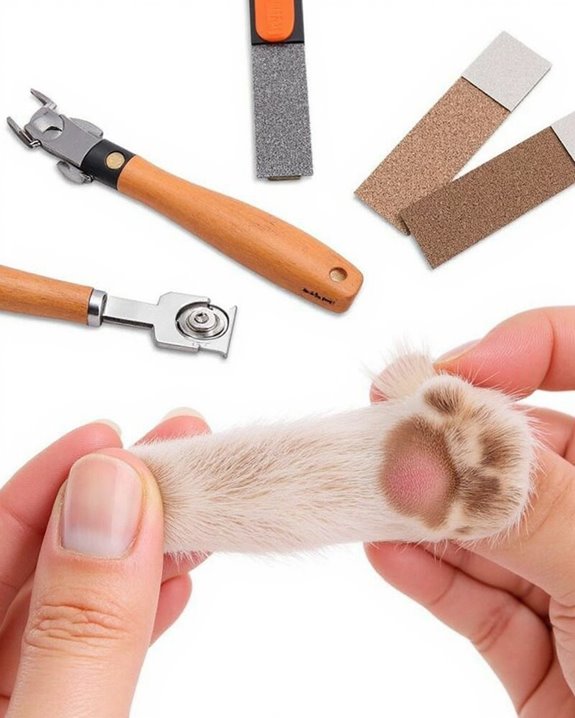
Understanding your dog’s nail anatomy is essential before attempting any trimming method without clippers. Each nail contains a sensitive quick—the pinkish inner core housing blood vessels and nerves—which you must avoid during nail clipping. In light-colored nails, I can easily see this quick, allowing me to cut safely beyond it, while dark nails require a more cautious approach using gradual, small cuts until I spot the gray-to-black ring indicating I’m nearing the quick.
When I accidentally cut into the quick, I immediately apply pressure to stop bleeding and make sure to disinfect the area. Regular maintenance helps recede an elongated quick over time, as both nail and quick shorten with consistent trimming. Always examine each nail’s structure carefully before proceeding—the hard outer shell protects the softer quick beneath it.
Creating Positive Associations During Nail Maintenance
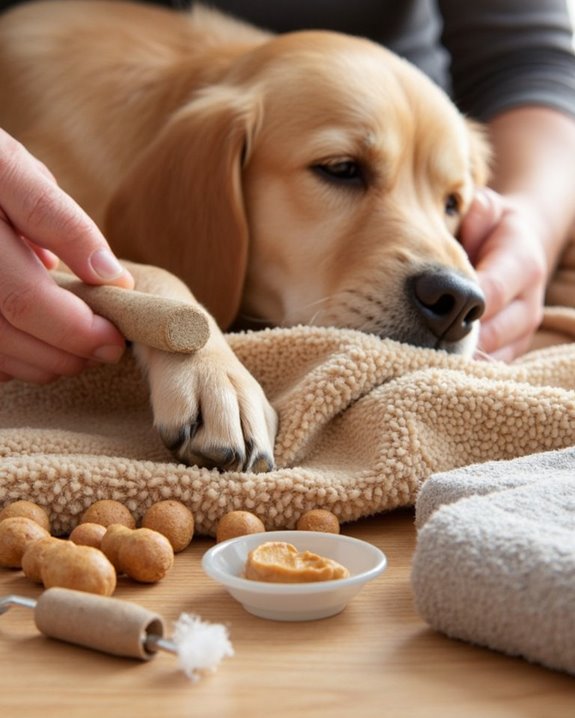
Building trust forms the cornerstone of successful clipper-free nail maintenance, connecting directly to our knowledge of nail anatomy. Many pet owners have used graduated introduction techniques with remarkable success, especially when their dog facing away feels more comfortable during the process. Start by rewarding your dog after handling just two nails, gradually working up to more as confidence builds.
Implement daily paw massages paired with high-value treats to create positive emotional responses. I recommend applying a small amount of peanut butter as a distraction while getting those first few nails clipped or filed. Track your dog’s progress in a journal, noting when they remain calm for five consecutive minutes. This systematic approach builds lasting positive associations, transforming nail care from a stressful event into a bonding opportunity.
Frequently Asked Questions
How Can I Cut My Dog’s Nails Without Clippers?
Isn’t nail maintenance more than just a chore? I use a Dremel tool or manual file for my anxious dog’s nails, maintaining trim frequency that provides health benefits while following safety precautions like watching for the quick.
What Can You Use as a Substitute for Dog Nail Clippers?
I recommend using Dremel tools or grinding stones as clipper alternatives. Emery files and filing pads work great for smaller dogs. Even natural abrasives like concrete scratching posts can wear down your pup’s nails gradually.
How to Cut a Dog’s Nails When You Can’t See the Quick?
When I can’t see the quick, I’ll use nail lighting techniques or visual aids to improve detection. I’ll trim cautiously with safety trimming methods, making small cuts and using avoidance techniques to prevent injury.
How Do Groomers Cut Dogs’ Nails That Won’t Let You?
As a groomer, I employ gentle restraint techniques, calming methods like treats, and handling tips tailored to anxious dogs. I’ll use behavioral approaches with positive reinforcement and sometimes muzzle options when necessary for everyone’s safety.


